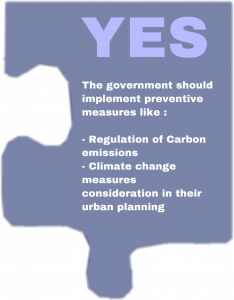Hi! Welcome to the last series of “To Move or Not To Move”!

Jakarta is vulnerable to climate change risks; particularly extreme weather events and sea-level rise. These climate change-induced events lead to the amplification of the pre-existing urban challenges.
Due to climate change, the surface and atmospheric temperature of Jakarta rises constantly and rapidly. It is predicted that the average surface temperature of Jakarta will be 28.5 degree Celcius by the year 2050.
The rise in temperature leads to the formation of more water vapour and it will subsequently lead to higher rainfall intensity or extreme weather events like torrential rain. In fact, the 2020 Greater Jakarta flood was due to intense overnight torrential rainfall, which is the worst rainfall in over a decade and it is presumed to be amplified by weather anomaly and climate change.
The temperature increase also leads to thermal expansion which subsequently leads to sea-level rise. The Intergovernmental Panel on Climate Change also predicted that sea levels will rise by one metre by 2100 if we are allowing a “business as usual” carbon emissions. This phenomenon occurs globally yet the impact can be highly localised, especially in Jakarta where coastal inundations are frequent.
Such events could cause environmental damages and hinder the productivity of the city, which is detrimental for Jakarta, the centre of administration for the country. Moreover, we have learnt from my previous posts about how land-subsidence causes the sinking of the capital. Now, we have seen how the problem of land subsidence has intersected with the issue of sea-level rise caused by human-induced climate change, which aggravated Jakarta’s “sinking situation”.
All the factors that come to interact are driven by humans. But since we are not able to prevent the existing climate crisis, what can the government do to minimise the impact if they choose to stay in Jakarta or relocate the capital?
If the government choose to not relocate the capital,
The government can implement palliative measures such as building sea walls and dikes. One notable ( or should I say notorious ) example is the Great Garuda project, a giant dike that creates a massive manmade lagoon, to save the capital and prevent flooding inland.
Yet, it requires the government to spend $40 billion dollars and the project itself is surrounded by controversies like the mass eviction. It could also create a septic lagoon, where there would be more pollution and sedimentation because waters are trapped inside the dike instead of being flushed out to sea, creating more environmental problems.
If the government choose to relocate the capital,
Then the government could create preventive measures. For instance, they could regulate the number of carbon emissions by companies or even individuals, to prevent increment in the local temperature, which could exacerbate the current global warming. They could also integrate the measures for climate change in their urban planning to dampen the adverse effect of climate change in the future.
Yet, due to the globalised impact of climate change, it is difficult to predict the extent of damage that would be experienced by the new capital and hence, it is hard to figure out which measures are suitable in the context of Borneo.
That’s all for today! Let me know which puzzle piece you choose this week and see you! (;


Hi Sherry,
It’s interesting to see how climate change is already affecting governments’ decisions. In this case, I do not see how shifting the capital will solve this issue. If anything, the urgency to tackle climate change will be lost as legislators are no longer confronted with its effect daily. The people of Jarkata may also be getting a raw deal as funds for palliative measures dry up (palliative seems rather apt in describing these mitigation measures btw).
I, too, wonder what environmental issues the Indonesian government may face in Kalimantan as compared to Java.
~STEK
Hi Ee Kin! Glad to see you here again <3 I completely agree with you how shifting the capital does not really solve the root cause of the problem. I agree that while it is crucial for the government to create a strong and productive centre of administration by relocating the capital, they should not abandon the fact that Jakarta will still be faced with these problems if they do not do something about it. Other than that, I believe that there are other environmental problems that the government may face in Kalimantan such as deforestation, loss of biodiversity, water scarcity, etc. which I will discuss in my next few posts!
Hi Sherry,
Another great post, overall. Let me ask you…
“It is predicted that the average surface temperature of Jakarta will be 28.5 degree Celcius by the year 2050.”
This, to me, is problematic for 3 reasons.
1) How much different is that from the avg surface Tº today ?
2) This is surface Tº – the value depends greatly on the surface cover, e.g., it is always much higher over low-albedo surfaces, so I don’t understand if this value assumes no change in land cover between now and 2050.
3) You follow up with an assertion that this leads to increased precipitation & thermal expansion (I assume you’re talking about the ocean). Well, neither result is directly related to land surface Tº in Jakarta. Thermal expansion of the sea results from heating of the water itself and increased water vapour with climate change is a complex outcome, but not one that is strongly linked to land surface Tº in Jakarta.
These issues (in 3 above) could mainly be a writing thing – maybe you weren’t specifically referring to surface Tº in the next paragraph, but that’s the message I think most readers will naturally receive. So do you want to clarify ?
Let me raise a second issue.
“But since we are not able to prevent the existing climate crisis…”
Shall I infer that you think there’s no hope of mitigating climate change ? I’m not saying that’s an invalid opinion – I’m just wondering if that is, in fact, your opinion.
Thanks,
jc
Hi Dr Coleman! Thank you for your questions! Currently, the mean surface temperature of Jakarta is 26.94 Celcius and the temperature differs by 1.6 Celcius which is quite significant.
I also believe that the researchers acknowledge the changes in land cover yet the data is merely an extrapolation of the trend of temperature in Jakarta for the past 100 years. Hence, perhaps changes in land cover is a confounder that they choose to not take into account in this studies
Other than that, I would like to clarify that it is the ocean temperature that is rising and causing thermal expansion instead of surface temperature. It cannot be denied that climate change causes the rise in both surface temperature and ocean temperature but these 2 lead to a different outcome ( or maybe several outcomes that are a combination of both factors such as the occurrences of more extreme weather events )
Other than that, I personally think that there is rather no hope of preventing climate change but it is possible to reduce the impact of it. Yet, it will be difficult because in the context of Jakarta, if the government want to build extra measures like a sea wall, it will increase the land pressure and might exacerbate the pre-existing land subsidence problems. Hence, I am not sure if the government is able to mitigate the effect of climate change effectively. Thank you!
Sherry
Thanks for your thoughtful reply.
OK, so you think we have no hope of preventing climate change, but we can still reduce its impact.
Something to think about (not necessarily respond to)…
– How urgent do you think this problem is?
– What do you think everyone’s respective responsibilities are to address it?
– What are you personally, as a young, Indonesian woman who will have a BES degree in 4 years, prepared to do, if you think your govt’s response will be inadequate?
🙂 jc
Thank you for your reply Dr Coleman!
I feel that the problem is very urgent and therefore there is the need to mitigate the impact immediately. There are various stakeholders in this issue and everyone need to work together to address this problem. For instance, the government can implement measures that I mentioned in my post. Business firms can also do their part and regulate their emissions so as to suppress the rapid increase in carbon dioxide emission and an increase in temperature. As an individual, we can also try to live more sustainably.
Personally, perhaps in 7 years ( after I fulfilled my work bond in Singapore haha ), I can use my skill and knowledge to work closely with Indonesian urban planning companies to share insights about what can we do to mitigate the impact of climate change and incorporate it in the planning process. After we can come up with concrete solutions, ideally we can present them to the public and to the government to highlight the severity of impact and therefore what can we do about it.
Sounds a bit idealistic, I guess. But one can dream! Thank you
Thanks Sherry ! Hopefully you can take some urban planning electives. There are several online courses as well. I would encourage you to find online networks too because there’s certainly room for urban-planning professionals in different regions to learn from & work with one another.
Thank you! I am planning on taking some urban planning electives! I will take initiatives in exploring this field of interest independently too!